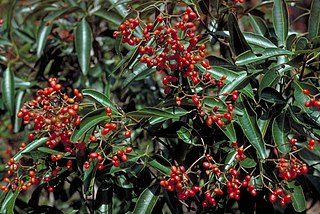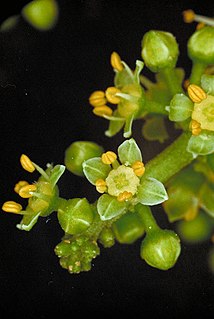
Flindersia is a genus of 17 species of small to large trees in the family Rutaceae. They have simple or pinnate leaves, flowers arranged in panicles at or near the ends of branchlets and fruit that is a woody capsule containing winged seeds. They grow naturally in Australia, the Moluccas, New Guinea and New Caledonia.

Flindersia ifflana, commonly known as hickory ash or Cairns hickory, is a species of tree in the family Rutaceae and is native to Papua New Guinea and Queensland. It has pinnate leaves with between four and twelve egg-shaped to elliptical leaflets, panicles of white or cream-coloured flowers and woody fruit studded with rough points.
Flindersia laevicarpa, commonly known in Australia as rose ash, scented maple or dirran maple, is a species of medium-sized to large tree in the family Rutaceae and is native to Papua New Guinea, West Papua and Queensland. It has pinnate leaves with four to eight egg-shaped to elliptical leaflets, panicles of cream-coloured, yellowish, red or purple flowers and smooth woody fruit that split into five at maturity, releasing winged seeds.

Flindersia pimenteliana, commonly known as maple silkwood, red beech or rose silkwood, is a species of tree in the family Rutaceae and is native to New Guinea and Queensland. It has pinnate leaves with three to seven egg-shaped to elliptic leaflets, panicles of red or reddish flowers and fruit studded with rough points.

Flindersia brayleyana, commonly known as Queensland maple, maple silkwood or red beech, is a species of tree in the family Rutaceae and is endemic to northern Queensland. It has pinnate leaves with between six and ten leaflets, panicles of white or cream-coloured flowers and smooth fruit that opens in five sections to release winged seeds.

Acradenia euodiiformis, commonly known as yellow satinheart or bonewood, is a species of tree that is endemic to eastern Australia. It has mostly trifoliate leaves, the leaflets narrow elliptic to lance-shaped, with prominent oil glands, and panicles of white flowers. It grows in and near rainforest.

Flindersia australis, commonly known as crow's ash, flindosy or Australian teak, is a species of tree that is endemic to north-eastern Australia. It has pinnate leaves with between five and thirteen egg-shaped to elliptical leaflets, white to cream-coloured flowers arranged in panicles on the ends of branchlets and followed by woody capsules studded with short, rough points and containing winged seeds.

Pentaceras australe, commonly known as bastard crow's ash, penta ash or black teak, is the only species in the genus Pentaceras in the plant family Rutaceae. It is a small to medium-sized rainforest tree endemic to eastern Australia. It has pinnate leaves with up to fifteen leaflets, small white flowers arranged in panicles on the ends of branchlets, and winged seeds.

Flindersia collina, commonly known as broad-leaved leopard tree, leopard ash, bastard crow's ash or leatherwood, is a species of tree in the family Rutaceae and is endemic to north-eastern Australia. It usually has pinnate leaves with between three and seven elliptical to spatula-shaped leaves, panicles of white flowers and fruit studded with rough points.

Flindersia xanthoxyla, commonly known as yellowwood, long jack or yellowwood ash, is a species of rainforest tree that is endemic to eastern Australia. It has pinnate leaves arranged in opposite pairs with seven to eleven leaflets, panicles of yellow flowers and woody fruit studded with rough points on the surface.

Flindersia bennettii, commonly known as Bennett's ash, is a species of tree in the family Rutaceae and is endemic to north-eastern Australia. It has pinnate leaves with between three and nine leaflets, cream-coloured flowers arranged on the ends of branchlets and woody fruit containing winged seeds.

Bosistoa pentacocca, commonly known as ferny-leaf bosistoa, native almond or union nut, is a species of tree that is endemic to eastern Australia. It has pinnate leaves arranged in opposite pairs with between three and thirteen leaflets and panicles of small flowers arranged in leaf axils or on the ends of branches. It grows along streams in rainforest.

Melicope bonwickii, commonly known as the yellow evodia or yellow corkwood, is a species of tree in the family Rutaceae and is native to Java and the Philippines, and southward to New Guinea and north-eastern Australia. It has trifoliate leaves and small pink flowers borne in panicles in leaf axils.

Bosistoa medicinalis, commonly known as the northern towra or Eumundi bosistoa, is a species of small to medium-sized rainforest tree that is endemic to Queensland. It has simple and pinnate leaves with two or three leaflets and panicles of small white flowers.

Bouchardatia neurococca, commonly known as union nut, is a species of small rainforest tree that is endemic to eastern Australia. It has pinnate leaves with three or five narrow elliptical leaflets, white flowers arranged in panicles, and oval follicles.

Dinosperma is a genus of plant containing the single species Dinosperma erythrococcum, commonly known as tingletongue, clubwood or nutmeg, and is endemic to north-eastern Australia. It is a tree usually with trifoliate leaves arranged in opposite pairs, the leaflets lance-shaped to oblong, and panicles of small white flowers, later bright orange to red, slightly fleshy follicles containing shiny, bluish black seeds.

Flindersia bourjotiana, commonly known as Queensland silver ash, northern silver ash, or white ash, is a species of tree that is endemic to Queensland. It has pinnate leaves arranged in opposite pairs and with between four and eight narrow egg-shaped to elliptic leaflets, greenish white flowers arranged in panicles, and fruit studded with short, rough points.

Flindersia dissosperma, commonly known as scrub leopardwood, is a species of small tree in the family Rutaceae and is endemic to eastern-central Queensland. It usually has pinnate leaves with between three and five elliptical to egg-shaped leaves, panicles of white to cream-coloured flowers and fruit studded with rough points.

Melicope vitiflora, commonly known as northern evodia, fishpoison wood, leatherjacket or leatherwood, is a species of shrub or small tree in the family Rutaceae and is native to north-eastern Australia and New Guinea. It has trifoliate leaves and green to white or cream-coloured flowers borne in panicles in leaf axils.

Melicope xanthoxyloides is a species of small tree in the family Rutaceae and is native to New Guinea and Queensland. It has trifoliate leaves and small green to yellow or cream-coloured flowers arranged in panicles in leaf axils.




















